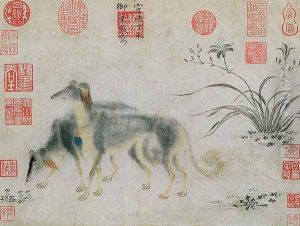Emperor Hsuan-tsung Paintings
Emperor Xuanzong of Tang, also known as Emperor Hsuan-tsung, was not an artist by the typical definition, but he was a significant patron of the arts and a ruler during a culturally rich period in Chinese history. Born Li Longji, he was the seventh emperor of the Tang dynasty, ruling from 712 to 756. His reign is often remembered for the prosperity and cultural achievements that occurred during the early part of his rule, which is sometimes referred to as the High Tang period.
Emperor Xuanzong's early reign was marked by administrative reforms, the consolidation of power, and the promotion of the arts. He took a keen interest in music and was instrumental in the development of the imperial music bureau known as the Pear Garden, which trained musicians and dancers for court performances and was a precursor to the conservatories of today. Emperor Xuanzong himself was known to be musically talented and composed several pieces. His court also became a gathering place for poets, artists, and scholars, and he was a great patron of the arts, commissioning numerous works and encouraging artistic development.
The emperor's encouragement of the arts and culture led to one of the most celebrated eras in Chinese poetry and painting. The period saw the flourishing of famous poets like Li Bai, Du Fu, and Wang Wei, whose works remain influential to this day. The era's painting and calligraphy also reached new heights with the development of landscape painting and the refined use of brushwork and ink.
However, Emperor Xuanzong's reign was not without its difficulties. In his later years, the An Lushan Rebellion broke out, a devastating civil war that lasted from 755 to 763. The rebellion severely weakened the Tang dynasty and led to a decline in the emperor's power and influence. It also ultimately led to Xuanzong's abdication in 756 in favor of his son, Emperor Suzong. Emperor Xuanzong spent the last years of his life in relative seclusion until his death in 762.
While Emperor Xuanzong is not remembered primarily as an artist, his contributions to the cultural and artistic heritage of China were significant, and his patronage helped to create an environment where the arts could thrive. His reign is often celebrated for its artistic achievements, and he remains an important historical figure in the context of Chinese art and culture.
